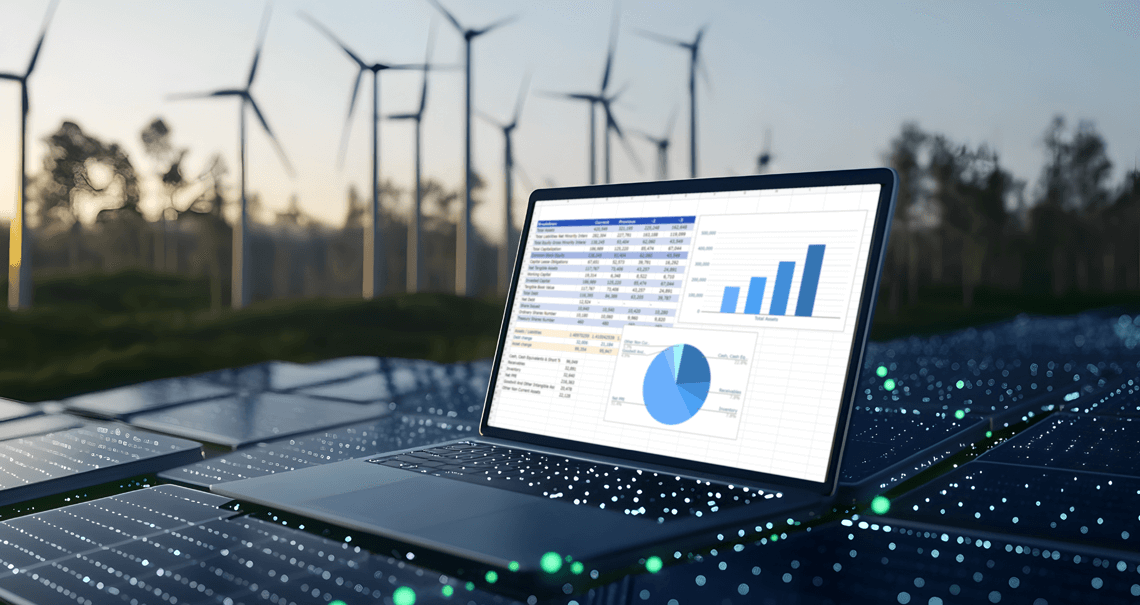How Future-Ready ETRMs Power Renewable Trading

Key Takeaways
- The energy transition is accelerating, creating both opportunities and risks.
- Renewable energy introduces volatility, complex pricing, and regulatory challenges.
- Modern ETRMs are essential for managing risk, ensuring compliance, and handling renewable portfolios.
The Energy Transition Is Here (And It’s Complicated)
The renewables market isn’t slowing down — but outdated systems are. As energy markets grow more volatile around the globe, the tools companies use to track and manage renewable portfolios need to move faster than ever to keep up.
This means that modern ETRM systems are no longer optional; they’re essential. They provide a reliable system of record that tracks transactions, provides a pro forma view of financial performance, and ensures compliance for complex renewable portfolios. Without modern solutions, businesses risk falling behind in a market that won’t wait for them to keep up.
So how can renewable energy producers and traders stay ahead — and uncover new opportunities — in a market that keeps changing?
Table of Contents
- What's Driving the Increased Demand for Renewables?
- The Challenges of Renewable Energy
- How Modern ETRMs Support Renewable Power
- The Future of ETRMs
- Modern ETRMs Help Tame Renewable Energy Volatility
What’s Driving the Increased Demand for Renewables?
Investment in renewable energy is surging due to both environmental goals and economic imperatives. But it's not just about what's being traded, it's also about how companies are managing their portfolios.
- Energy Security: Nearly 80% of the world’s population lives in countries that import fossil fuels, making them vulnerable to geopolitical tensions. Local renewable sources such as solar and wind reduce reliance on imports.
- Cost Declines: The cost of electricity from solar power fell by 85% between 2010 and 2020, with similar reductions in wind power costs.
- Decarbonization & Climate Goals: Reducing greenhouse gas emissions is a major driver for renewable energy adoption. With fossil fuels being the largest contributor to global climate change, transitioning to renewables is essential for meeting net-zero targets. Countries and corporations alike are accelerating decarbonization efforts, making renewables a critical part of future energy strategies.
The Challenges of Renewable Energy
While switching to renewable energy can deliver environmental, geopolitical, and even financial benefits, renewable energy production comes with its own challenges — especially when it comes to tracking and managing complex power portfolios.
- Generation is unpredictable. Unlike fossil fuels, many types of renewable generation are inherently volatile. Both wind and solar only produce energy at certain times of day and are affected by weather conditions, leading to fluctuating hourly production capacity. This volatility creates risk and makes forecasting difficult.
- Power markets move fast. Power markets are priced hourly, or even sub-hourly, to account for variations in demand, and the need to keep the grid in balance. There can be a large difference between peak and off-peak pricing and some nodes will even regularly experience negative pricing. A lack of up-to-date insights means traders risk missing profitable opportunities or mismanaging their exposure.
- Legacy systems and spreadsheets aren’t built for the complexities of renewable trading. Many companies still rely on outdated systems that lack automation, real-time tracking, and reliable position visibility — so it’s too difficult to track renewable attributes like vintages, expiries, and offsets accurately. Instead of focusing on making smart decisions, teams just end up buried in manual processes.
How Modern ETRMs Support Renewable Power
Modern, scalable ETRMs capable of handling the complexities of renewable portfolios are essential to staying competitive in today’s energy markets.
Advanced Data Management
Modern ETRMs have specialized functionality to handle the large, complex datasets associated with renewable portfolios and power purchase agreements (PPAs), which often involve tracking tens or hundreds of thousands of data points across multiple energy and pricing sources.
These systems offer automated data flows through APIs and integrations, and flexible data models to handle evolving demands from consumers, counterparties, grids, exchanges and regulators.
Portfolio and Risk Management
Modern ETRMs help market participants manage risk by enabling them to assess and counteract market, credit, and operational risks associated with energy trading activities. By providing reporting based on reliable, up-to-date data, in a single system, the ETRM allows users to identify potential exposures, implement hedging strategies, monitor market fluctuations, and ensure compliance.
Renewable Certificates
In addition to regulatory demands, companies that trade renewables must also manage the complexity of production-linked certificates and obligations. These certificates, including renewable certificates and allowances, offsets, and derivative instruments, have unique contracting, eligibility, and pricing challenges. ETRMs with advanced capabilities for renewable certificates and managing them through their entire lifecycle.
Key features of modern ETRMs for renewables include:
- Automated processes: Match and allocate physical certificates with the commodities that generated or consume them and capture type-specific fields, such as eligibility, class, and expiry
- Lifecycle oversight: Optimize renewables trades and manage the full lifecycle of renewable instruments
- Certificate management: Track certificates down to the serial number level to accurately manage inventory and deliver a comprehensive audit trail of all certificate proposals and linked demand retirements
- Custom reporting ability: Including how credits offset carbon positions, the value of inventory, allocation gaps, regulatory compliance, and more
Legacy systems do not have this specialized functionality, making them ineffective tools for managing all the intricacies of renewable energy trading. In contrast, modern ETRMs are modular, agile, and robust solutions designed to keep pace with today’s energy markets.
The Future of ETRMs
Demand for renewable energy continues to grow – especially with advances in battery technology and growing power needs for data centers This will add complexity to an already complex, volatile market. Demand for new ETRM functionality will also increase in a renewables-driven economy, requiring ETRM systems to evolve to support complex portfolios with large datasets.
To keep up with this constant pace of change, ETRM systems must be scalable, agile, and reliable. Therefore, modern ETRMs need to be cloud-based and multi-tenant to easily model new lines of business.
Modern ETRMs Help Tame Renewable Energy Volatility
Modern ETRMs can support energy companies as they transition to a more diverse energy portfolio, ensuring regulatory compliance and handling the complexities of diverse renewable commodities. These modern systems have customized modules to manage renewable instruments and are built to handle more complex pricing, forecasting, trading, and risk mitigation.
Energy markets will continue to evolve as countries seek to reduce carbon emissions and increase energy independence. New technologies, such as more efficient industrial batteries, will accelerate the energy transition.
Companies that want to stay ahead must invest in future-focused ETRM solutions as part of their renewables trading strategy, so they can ensure they have the forecasting, tracking, and reporting functionality they need to evolve with energy markets.



